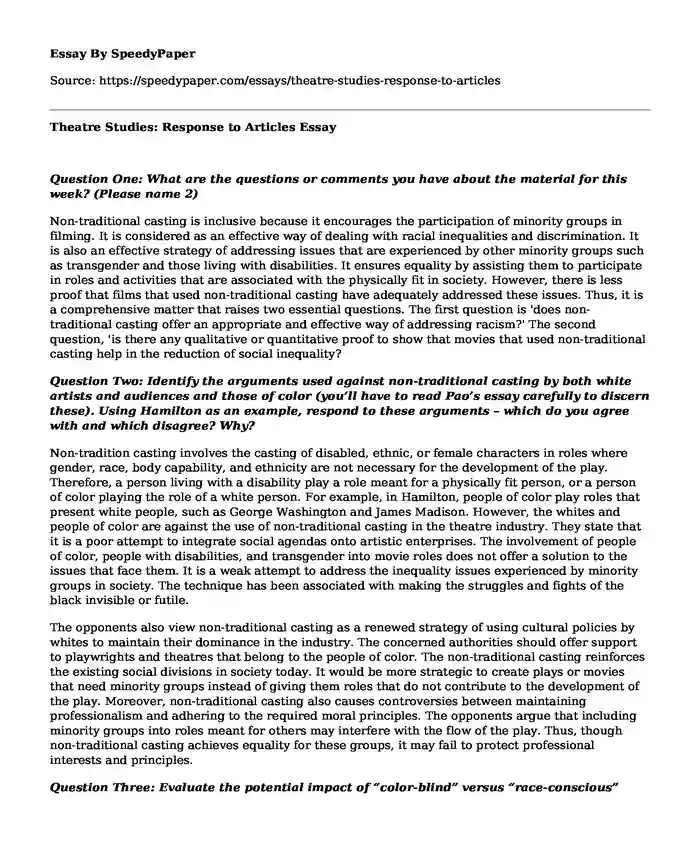Question One: What are the questions or comments you have about the material for this week? (Please name 2)
Non-traditional casting is inclusive because it encourages the participation of minority groups in filming. It is considered as an effective way of dealing with racial inequalities and discrimination. It is also an effective strategy of addressing issues that are experienced by other minority groups such as transgender and those living with disabilities. It ensures equality by assisting them to participate in roles and activities that are associated with the physically fit in society. However, there is less proof that films that used non-traditional casting have adequately addressed these issues. Thus, it is a comprehensive matter that raises two essential questions. The first question is 'does non-traditional casting offer an appropriate and effective way of addressing racism?' The second question, 'is there any qualitative or quantitative proof to show that movies that used non-traditional casting help in the reduction of social inequality?
Question Two: Identify the arguments used against non-traditional casting by both white artists and audiences and those of color (you’ll have to read Pao’s essay carefully to discern these). Using Hamilton as an example, respond to these arguments – which do you agree with and which disagree? Why?
Non-tradition casting involves the casting of disabled, ethnic, or female characters in roles where gender, race, body capability, and ethnicity are not necessary for the development of the play. Therefore, a person living with a disability play a role meant for a physically fit person, or a person of color playing the role of a white person. For example, in Hamilton, people of color play roles that present white people, such as George Washington and James Madison. However, the whites and people of color are against the use of non-traditional casting in the theatre industry. They state that it is a poor attempt to integrate social agendas onto artistic enterprises. The involvement of people of color, people with disabilities, and transgender into movie roles does not offer a solution to the issues that face them. It is a weak attempt to address the inequality issues experienced by minority groups in society. The technique has been associated with making the struggles and fights of the black invisible or futile.
The opponents also view non-traditional casting as a renewed strategy of using cultural policies by whites to maintain their dominance in the industry. The concerned authorities should offer support to playwrights and theatres that belong to the people of color. The non-traditional casting reinforces the existing social divisions in society today. It would be more strategic to create plays or movies that need minority groups instead of giving them roles that do not contribute to the development of the play. Moreover, non-traditional casting also causes controversies between maintaining professionalism and adhering to the required moral principles. The opponents argue that including minority groups into roles meant for others may interfere with the flow of the play. Thus, though non-traditional casting achieves equality for these groups, it may fail to protect professional interests and principles.
Question Three: Evaluate the potential impact of “color-blind” versus “race-conscious” casting practices on the ways we think about race in the US. What is the difference between what these terms mean? In your estimation, is it possible to cast or watch a play “color-blind?”
Color-blind casting involves choosing characters or allocating the roles in a play without considering the race, gender, or ethnicity of an individual. The experienced and qualified actors are given their roles. The directors should ignore any concerns about the skin color of an individual. On the other hand, race-conscious casting is the opposite of color-blind as it considers the social categories such as color, race, and culture when giving roles to characters in a play. The conceptual and cross-cultural castings are types of race-conscious casting. Conceptual casting focuses on bringing out significant concepts or resonance in a play by using disabled actors or people from minority ethnicities. Cross-cultural casting involves the translation of a movie to present a different cultural setting. Race-conscious casting creates a relationship between the race of the character and the original character being depicted.
The color-blind and race-conscious casting helps people in the US to appreciate the role of other minority groups not in the theatre but also other sectors like education. It enables the people of color to have equal opportunities based on their qualifications and not a race. It provides of judging people based on their character and not their skin color. I believe it is possible to achieve color-blindness in movies and plays. The film directors have to focus on a character based on their ability without considering the color. The Hamilton musical is a piece that has achieved color-blindness. Color-blind movies can be produced if people focus on maintaining professionalism instead of responding to moral obligations and stereotypes.
Cite this page
Theatre Studies: Response to Articles. (2023, Dec 25). Retrieved from https://speedypaper.net/essays/theatre-studies-response-to-articles
Request Removal
If you are the original author of this essay and no longer wish to have it published on the SpeedyPaper website, please click below to request its removal:
- Historical Essay Sample on Cambodia's Genocide
- Free Essay about Education for People with Disabilities
- Legal vs. Ethical: Examining Culture and Leadership. Paper Example
- Free Essay Example - the Entertainer
- Essay Example. Women and Gender Studies
- If You Meet Buddha Along the Road, Kill Him! Essay Example
- Essay on Black Resistance of the Jim Crow Laws
Popular categories





